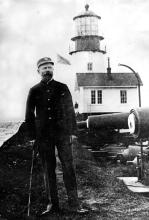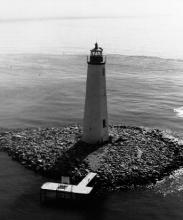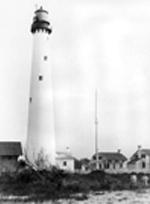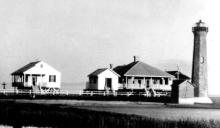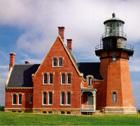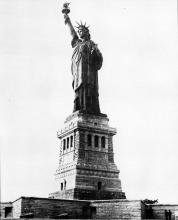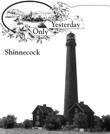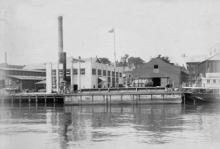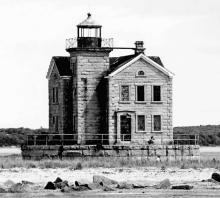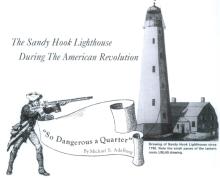Cape Disappointment Lighthouse
The Columbia River, 1,210 miles in length, is the second longest river in America. Twice a day a huge volume of water running to the sea encounters an incoming tide at the mouth of the river. This phenomenon, coupled with the wind and currents from the northwest, causes heavy surf and a dangerous bar situation. John Meares sighted Cape Rogue, as it was initially called, on July 6, 1788. Captain Meares tried to find an entrance to escape the high seas he was experiencing.
- Read more about Cape Disappointment Lighthouse
- Log in to post comments
New Point Comfort Lighthouse
A lone tower surrounded by water and rip rap, the lighthouse at New Point Comfort has weathered a constantly shifting shoreline as well as occupation by enemy troops in two wars. That the tower has survived for nearly two centuries is truly remarkable. The tenth oldest intact lighthouse in our nation, it was once part of an onshore station first lit in 1805.
- Read more about New Point Comfort Lighthouse
- Log in to post comments
Cape Charles Lighthouse
The town of Cape Charles was a busy seaport in the 19th century. On May 18, 1826, Congress appropriated $40,000 to construct a lighthouse on Smith Island, just off Cape Charles, VA. This island marks the northern side of the entrance into Chesapeake Bay. The light station was named Cape Charles.
- Read more about Cape Charles Lighthouse
- Log in to post comments
Aransas Lighthouse (also known as Lydia Ann Light)
With the exception of the approaches to New Orleans, lighthouse construction along the Gulf Coast lagged behind other areas of the country and certainly didn’t keep pace with the increasing maritime trade in the area.
Block Island Southeast Lighthouse
Block Island is situated twelve miles south of the mainland (Rhode Island) and about fifteen miles northeast of southern tip of Long Island. Block Island is roughly pear shaped on a north-south axis, with the "stem of the pear" consisting of a sandy spit (Sandy Point) and a submerged sand bar which extends over 1-1/2 miles to the north. Some 500 vessels have come to grief on this obstruction over the years.
- Read more about Block Island Southeast Lighthouse
- Log in to post comments
Statue of Liberty Lighthouse
Her vital statistics and historical facts can be neatly recorded, but she defies classification. She is a late 19th-century engineering wonder; a monument of art; an architectural form; and she speaks eloquently, if silently, for the spirit of liberty. She stands in New York Harbor but belongs to the whole nation. Her essence combines the tangible with the intangible. She is the Statue of Liberty Enlightening the World.
- Read more about Statue of Liberty Lighthouse
- Log in to post comments
Shinnecock Lighthouse
To assist vessels navigate the length of Long Island lighthouses were built at Montauk Point and Fire Island. However, this left a dark hole between the two stations, and in 1854 the Lighthouse Board successfully petitioned Congress to construct a station at Shinnecock, almost midway between the two. These three major seacost lights would ensure that the mariner always had at least one light in sight as he navigated along the south shore of Long Island.
- Read more about Shinnecock Lighthouse
- Log in to post comments
The General Light-House Depot Reborn
Over the past century and a half, a slice of lighthouse history on the Staten Island waterfront, just across New York Harbor from lower Manhattan, has seen its fortunes rise and fall. Now, it may again be on the rise—and back in the service of lighthouses.
- Read more about The General Light-House Depot Reborn
- Log in to post comments
Cedar Island Lighthouse
Perhaps no other light station on Long Island has experienced as many ups and downs as Cedar Island. From the glory of Sag Harbor’s whaling days and the laughter of many children, through erosion, storms, and abandonment, to the current struggle just to remain standing, this light station has had its share of good times, as well as bad.
- Read more about Cedar Island Lighthouse
- Log in to post comments
Sandy Hook Lighthouse During the American Revolution
Built in 1764, on the tip of the Sandy Hook Peninsula, near the head of New York Harbor, the Sandy Hook Lighthouse predates the United States by more than a decade. Yet far from being a great patriotic symbol during the Revolution, the Sandy Hook Lighthouse was the center of a menacing British presence throughout the war. It is a little known irony that the lighthouse would not be standing today if America's patriots had had their way.

